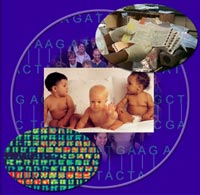|
September 23-24, 2002
Atlanta, GA |

Individual states have gone to varying degrees in developing policies and using state-based spot banks for public health applications. The Office of Genomics and Disease Prevention in collaboration with the Newborn Screening Branch in the National Center for Environmental Health and the Center on Birth Defects and Developmental Disabilities hosted a meeting to bring states together to discuss state experiences and develop a collaborative, strategic plan for the future. |
Goals
Newborn screening (NBS) programs collect dried blood spots (DBS) in every state for the approximately 4 million children born each year. Leftover DBSs are available after routine metabolic, endocrine, hematologic and other screening tests so re-testing can be performed, if needed. Over 95% of newborns have leftover DBS retained by state programs for some time period. These leftover DBS specimens are a unique, valuable population-based source for important public health surveillance and potential epidemiologic research, including population-based data on prevalence of genetic variants, markers of environmental exposure and infectious disease and constitute a specimen bank of a large cohort of state populations. Advances in human genetics, gene discovery, and the Human Genome project will play a central role in medicine and public health in the 21st century. Assessing the impact of genetic variation on the health of populations will be critical to guide public health research, policy, and practice on using genetic information to prevent disease. In collaboration with state health departments and other partners, we would like to examine the feasibility of establishing a bank of leftover newborn dried blood spot (DBS) specimens and assess the logistical structure for controlled access to a multi-state spot banks or a central spot bank. The purpose of the banks would be to provide a unique resource for obtaining population-based data on prevalence of gene variants of public health significance, and the association of gene variants with disease and risk factors, including measuring markers of environmental exposure, infectious disease, or risk factors associated with developmental disabilities and chronic disease. These population-based data would also form the basis for the National Report on Genomics and Public Health, a new multi-CIO CDC collaboration to present current population-based data on the impact of genomics on public health.
 List of Participants List of Participants
 Meeting Agenda Meeting Agenda
 Background Slide Set Background Slide Set
|


